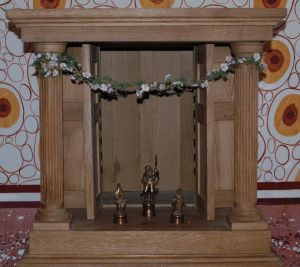Household worship
(Added a section and link to page on gestures in roman prayer (Piscinus' post)) |
|||
| Line 15: | Line 15: | ||
The modern rituals for Cultores of the Religio Romana may be found here: [[Daily Rituals (Nova Roma)]] | The modern rituals for Cultores of the Religio Romana may be found here: [[Daily Rituals (Nova Roma)]] | ||
| + | |||
| + | == Gesture in roman prayer == | ||
| + | |||
| + | You can find here a very useful post (originally the calendar post for a. d. VII Kalendas Februarias ‡ M. Curiatio M. Iulio cos. ‡ [[MMDCCLXII]] a.u.c. ) about [[gestures in roman prayer]]. | ||
| + | It explains how to use your hands when praying to the different categories of gods. | ||
[[Category:Religio Romana]] | [[Category:Religio Romana]] | ||
[[Category:Ritus]] | [[Category:Ritus]] | ||
Revision as of 01:00, 27 January 2009
Home | Latíné | Deutsch | Español | Français | Italiano | Magyar | Português | Română | Русский | English
⚜⚜⚜ Site Index - Key Pages ⚜⚜⚜

Each household in Rome was in a sense a temple to the gods. All Roman homes had a household altar, or "lararium", at which the family interacted with the goddesses and gods on a personal level each day. The rites of the home and family were so important to the Romans that such worship persisted into very late antiquity, surviving centuries longer than the public manifestations of the cultus deorum, which were officially banned in the late 4th century CE.
The reasons that household worship was important are understandable even today. The family is the basis of Roman culture, and the household is the "center" of a family's existence. Inviting the gods into one's house helps to ensure that one's property, relatives, and worldly efforts are blessed by the Roman deities, and that the positive powers of the goddesses and gods will enrich one's daily life. Such a sharing of life between humans and the gods is the essence of the Pax Deorum, or "Peace of the Gods."
The Basic Outline of Household Worship
The basics of cultus deorum household worship are simple and easy to do. A lararium is set up in the home, at which both the deities that are responsible for the home and the patron deities of the family are worshipped. Historically, there are two simple rites done at the lararium each day: in the morning and in the evening. During these rites the gods are honored, and asked to watch over the affairs of the family. The lararium was of course also a place where individuals could worship the gods privately, and make small offerings to them.
Lararium Rituals
The modern rituals for Cultores of the Religio Romana may be found here: Daily Rituals (Nova Roma)
Gesture in roman prayer
You can find here a very useful post (originally the calendar post for a. d. VII Kalendas Februarias ‡ M. Curiatio M. Iulio cos. ‡ MMDCCLXII a.u.c. ) about gestures in roman prayer. It explains how to use your hands when praying to the different categories of gods.